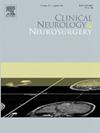颈动脉井喷综合征的血管内介入治疗及复发预测因素:一项回顾性多中心队列研究。
IF 1.8
4区 医学
Q3 CLINICAL NEUROLOGY
引用次数: 0
摘要
简介颈动脉爆裂综合征(CBS)是头颈部癌症及相关治疗的一种潜在威胁生命的并发症。在这项研究中,我们以 CBS 复发为重点,评估了解构和重建手术的安全性和有效性:我们对前瞻性维护的数据库进行了多中心回顾性分析,确定了 2016 年至 2020 年间 80 例连续的 CBS 神经介入治疗。患者分为两组:解构性栓塞术(68 例)和重建性支架植入术(12 例)。对两组患者进行了对比分析:CBS的复发率为23.8%,其中84.2%的复发发生在原发后90天内。再出血的中位时间为 8.0 天(IQR:2.0 - 28.5),死亡率为 26.3%。围手术期缺血性中风率(1.5% 对 0%,P=0.672)或围手术期死亡率(1.5% 对 0%,P=0.670)无明显差异。重建组的 CBS 复发率明显更高(58.3% 对 17.6%,P=0.002)。多变量分析显示,重建支架可独立预测再出血(调整后危险比为 8.31,95 % CI:2.34-29.59,p=0.001)。CBS复发与术前(P=0.600)或术后(P=0.275)使用抗凝剂/抗血小板之间无明显关联:结论:CBS仍然是头颈部癌症的一种具有挑战性和潜在灾难性的并发症。重建手术(包括支架植入术)可预测 CBS 复发,与出血部位或肿瘤侵犯无关。根据CBS复发的时间间隔进行术后监测,以及包括改良血管重建装置在内的工程技术进步,都有可能降低再出血率并改善患者预后。还需要在更大的群体中开展进一步的临床研究。本文章由计算机程序翻译,如有差异,请以英文原文为准。
Endovascular intervention for carotid blowout syndrome and predictors of recurrence: A retrospective and multicenter cohort study
Introduction
Carotid blowout syndrome (CBS) is a potentially life-threatening complication of head and neck cancer and associated treatment. In this study, we assess the safety and efficacy of deconstructive and reconstructive procedures with a focus on CBS recurrence.
Methods
We conducted a multicenter retrospective analysis of a prospectively maintained database and identified 80 consecutive neurointerventions for CBS from 2016 to 2020. Patients were divided into 2 groups: deconstructive embolization (68 patients) and reconstructive stenting (12 patients). A comparative analysis was performed between the two groups.
Results
The CBS recurrence rate was 23.8 % with 84.2 % of recurrences occurring within 90 days of the primary event. The median time to rebleeding was 8.0 days (IQR: 2.0 – 28.5) with a mortality rate of 26.3 %. There was no significant difference in rates of peri-operative ischemic stroke (1.5 % vs. 0 %, p=0.672) or peri-operative mortality (1.5 % vs. 0 %, p=0.670). CBS recurrence was significantly higher in the reconstructive group (58.3 % vs. 17.6 %, p=0.002). On multivariate analysis, reconstructive stenting independently predicted rebleeding (adjusted hazard ratio 8.31, 95 % CI: 2.34–29.59, p=0.001). There was no significant association between CBS recurrence and pre-operative (p=0.600) or post-operative (p=0.275) anticoagulant/antiplatelet use.
Conclusion
CBS remains a challenging and potentially catastrophic complication of head and neck cancers. Reconstructive procedures, including stenting, predicted CBS recurrence independent of bleeding site or tumor invasion. Postoperative surveillance based on time intervals to CBS recurrence and engineering advancements including improved vessel reconstruction devices have the potential to reduce rehemorrhage rates and improve patient outcomes. Further clinical investigations amongst larger cohorts are needed.
求助全文
通过发布文献求助,成功后即可免费获取论文全文。
去求助
来源期刊

Clinical Neurology and Neurosurgery
医学-临床神经学
CiteScore
3.70
自引率
5.30%
发文量
358
审稿时长
46 days
期刊介绍:
Clinical Neurology and Neurosurgery is devoted to publishing papers and reports on the clinical aspects of neurology and neurosurgery. It is an international forum for papers of high scientific standard that are of interest to Neurologists and Neurosurgeons world-wide.
 求助内容:
求助内容: 应助结果提醒方式:
应助结果提醒方式:


